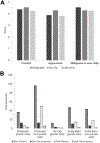A Novel, Wearable Inertial Measurement Unit for Stroke Survivors: Validity, Acceptability, and Usability
- PMID: 38441511
- PMCID: PMC11144559
- DOI: 10.1016/j.apmr.2024.01.020
A Novel, Wearable Inertial Measurement Unit for Stroke Survivors: Validity, Acceptability, and Usability
Abstract
Objective: To establish the concurrent validity, acceptability, and sensor optimization of a consumer-grade, wearable, multi-sensor system to capture quantity and quality metrics of mobility and upper limb movements in stroke survivors.
Design: Single-session, cross-sectional.
Setting: Clinical research laboratory.
Participants: Thirty chronic stroke survivors (age 57 (10) years; 33% female) with mild to severe motor impairments participated.
Interventions: Not Applicable.
Main outcome measures: Participants donned 5 sensors and performed standardized assessments of mobility and upper limb (UL) movement. True/false, positive/negative time in active movement for the UL were calculated and compared to criterion-standards using an accuracy rate. Bland-Altman plots and linear regression models were used to establish concurrent validity of UL movement counts, step counts, and stance time symmetry of MiGo against established criterion-standard measures. Acceptability and sensor optimization were assessed through an end-user survey and decision matrix.
Results: Mobility metrics showed excellent association with criterion-standards for step counts (video: r=0.988, P<.001, IMU: r=0.921, P<.001) and stance-time symmetry (r=0.722, P<.001). In the UL, movement counts showed excellent to good agreement (paretic: r=0.849, P<.001, nonparetic: r=0.672, P<.001). Accuracy of active movement time was 85.2% (paretic) and 88.0% (nonparetic) UL. Most participants (63.3%) had difficulty donning/doffing the sensors. Acceptability was high (4.2/5).
Conclusions: The sensors demonstrated excellent concurrent validity for mobility metrics and UL movements of stroke survivors. Acceptability of the system was high, but alternative wristbands should be considered.
Keywords: Gait; IMU; Stroke; Upper limb; Wearables.
Copyright © 2024 American Congress of Rehabilitation Medicine. Published by Elsevier Inc. All rights reserved.
Figures





References
-
- Tsao CW, Aday AW, Almarzooq ZI, et al. Heart disease and stroke statistics-2023 update: a report from the American Heart Association. Circulation 2023;147:e93–e621. - PubMed
-
- Lieshout ECC van, van de Port IG, Dijkhuizen RM, Visser-Meily JMA. Does upper limb strength play a prominent role in health-related quality of life in stroke patients discharged from inpatient rehabilitation? Top Stroke Rehabil 2020;27:525–33. - PubMed
-
- Price R, Choy NL. Investigating the relationship of the Functional Gait Assessment to spatiotemporal parameters of gait and quality of life in individuals with stroke. J Geriatr Phys Ther 2019;42:256–64. - PubMed
Publication types
MeSH terms
Grants and funding
LinkOut - more resources
Full Text Sources
Medical

